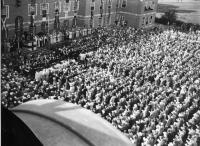The numbers at Oxford house-parties kept on rising. Almost 1,000 people registered on one day in July 1935, twice the previous record for a day's arrivals, and there were 6,000 for a meeting on the lawns of Lady Margaret Hall. Nor was it only Oxford which drew the crowds. In January 1935 1,400 went to a house-party in Malvern, called at the suggestion of the Bishop of Worcester; and this was followed by a series of meetings in Penge, in South London, to which 4,000 went and which the Bishop of Croydon welcomed in glowing terms.

For Buchman himself, however, life was not all moonlight and roses. That summer he was asked by General Lynden Bell to spend a day in the Buffs'* tent at Canterbury Cricket Week. J. L. Guise, the Oxford and Middlesex cricketer, drove him there from Oxford via London, as Buchman wanted to buy a suitable tie for the occasion. The tie of the Eton Ramblers took his fancy, and Guise only persuaded him to purchase something more neutral 'with considerable difficulty'. The whole occasion turned out something of a 'baptism of fire' for Guise, who relates: 'I shall never forget that day; until then I had not realised the degree of persecution and opprobrium Frank had to endure. Bishops, high-ranking soldiers and cricketers packed the marquee and most were holding Frank in suspicious sidelong glances. "There's Frank Buchman", one could hear them mutter to each other. For me it was the test of a lifetime, for I was well-known in the world of cricket and to be Frank's companion meant meeting the same hostility. Only one person was perfectly at ease in every conversation and introduction we had and that person was Frank; he remained his natural cheerful self throughout. ... Driving home in the evening, Frank suddenly pointed to a small cottage . . . and asked me to stop as an old friend of his, a gardener, lived there whom he had not seen for many years. It was a full hour before he came out, very happy that he had found his old friend well and in good heart, though getting on in years.''18
(* Bells exclusive regiment.)
The Group's younger and more ebullient supporters were, of course, the last to play down the significance of the sudden expansion of numbers. When four teams of students were commissioned to visit the South Coast, London, the Midlands and the North respectively, the Group's publicity declared that 'this marked in England and perhaps for the world a revival fully as significant as the Reformation'; while one young enthusiast regarded the arrival of 300 Canadians and Americans at the 1934 house-party as 'the most significant event since the sailing of the Mayflower'. Their history was faulty, to say the least. But a less biased witness, the unregenerate Malcolm Muggeridge, wrote in his book The Thirties that in half a decade the Oxford Group had generated the only genuine religious revival of the period.19
161
Photo: The crowd of 6,000 people at an Oxford Group house-party at Lady Margaret Hall, Oxford, 1935.
©Scoville Wishard/MRA Productions